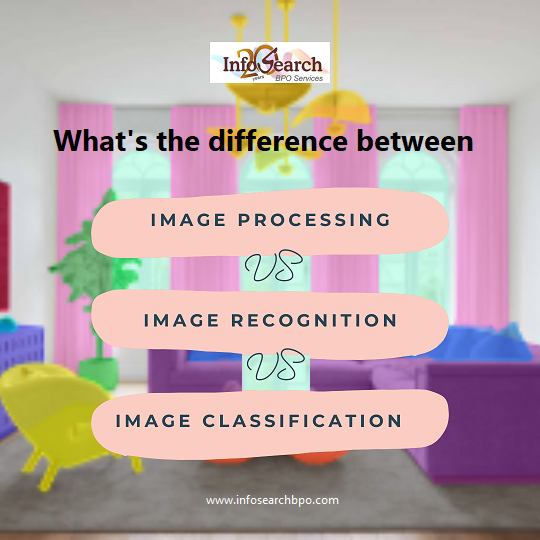Infosearch provides the following image annotation services for computer vision.
In this visually-oriented age and era, the forms of technology that enable the machines to see and read the image are becoming mandatory in all fields, like healthcare and auto industry and retail stores and security. Image processing, image recognition and image classification are terms commonly applied interchangeably, in fact, they are different phases and methods in computer vision.
Here, we deconstruct the differences, the relationship and why these differences are important whether you are a developer, a data scientist or a business leader looking at AI solutions.
📸 1. What Is Image Processing?
Computer vision is based upon image processing. It allows manipulating or improving images in order to render them more analyzable.
Popular Uses Cases:
- Getting rid of noise or distortion
- Enhancing differences or clarity
- Convert grayscale images – Convert gray scale color images
- resizing or cropping
- Segmentation and edge detection
Real-World Example:
An image may have an image processing procedure before it is fed into an AI model to make it clean, clear, and standard. By way of example, an X-ray may be refined in medical imaging, so that fractures become more visible.
Consider image processing as preparation and cleaning the image, but not interpretation of that image.
🧠 2. What is image recognition?
Image recognition is referred to as what a machine can recognize in an image, this may be an object, a person, a scene or a movement. One step beyond the processing is the turning of the visual material into something your brain can make sense of.
Typical Scenario Applications:
- Face recognition program (i.e., unlocking your phone)
- Object detection (e.g. the detection of cars and people in autonomous cars)
- Bar code /text scanning
- Picture based search engines (ex: identify the like product by photo)
Real-World Example:
A handbag in a photo of a user can be identified with an e-commerce app and offer similar alternatives sold.
Image recognition has the question, what is in this image?
🧩 3. What Is Image Classification?
The recognition part may be further broken down into image classification, in which case the task is to assign an image to one of a predefined number of classes; and object location, when the goal is to localize the object of interest within the image.
Typical Applications:
- Categorizing photos (e.g. cats/dogs)
- Diagnosis of illness using medical images
- Blocking out unsuitable content in social websites
- Categorizing hand written numerals (as in postal automation)
Real-World Example:
Smart agriculture application Deep learning model differentiates between an image that possesses a healthy leaf and an image that has a diseased leaf.
The question that will be answered by image classification is: what category does this image fit into?
Their Way of collaboration
The three concepts usually collaborate in the pipeline:
- The raw image data is enhanced by Image Processing.
- Image Recognition identifies the objects or the areas of interest.
- Image Classification assigns labels to the content (e.g. apple, banana or orange).
In a nutshell:
Process Analogy
Image Processing Cleaning your glasses in order to see better
Image Recognition Observing the things that you see
Image Classification Making choice on the names of objects
Tool/Technologies Involved
- Image Processing: OpenCV, PIL, Scikit-Image
- Image Recognition: tensorflow, PyTorch, YOLO, Detectron
- Image Classification: CNNs (Convolutional Neural Networks), ResNet, VGGNet
Conclusion
Understanding the difference between image processing, recognition, and classification to develop better AI-based solutions. No matter if you work on cleaning up an image, object identification, or labeling, all of these steps are essential to extract intelligence out of visual data.
When developing a computer vision app, be sure to consider all three of these things when engineering your pipeline, so that your app is both high performance and accurate.
Contact Infosearch for all your data annotation services.








Recent Comments